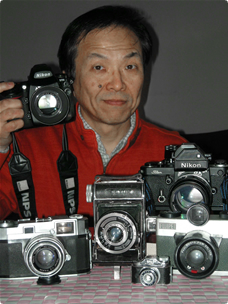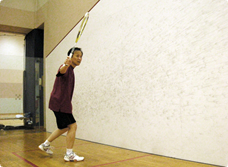The Time to Enjoy Photography Is Now
The best product designers and developers are those who enjoy photography themselves
Would you say that digital cameras have increased the number of photography enthusiasts?
They certainly have. In the days of film cameras, it was more difficult to casually get involved in photography. Digital cameras, however, enable anyone to join in anytime, as users don’t have to worry about loading film, they can check their images on the spot and so on. The hurdles to becoming more closely involved in photography have been substantially lowered. More than 100 million digital cameras are now marketed worldwide every year. At their peak, film cameras sold some 30 or so million units worldwide. Digital cameras have extended the joys of photography to far more people than ever before. The ways to enjoy photos now range from prints on paper, to slideshows on TV screens, digital photo frames and mobile phone displays. So digital cameras have increased the enjoyment not only of shooting, but viewing as well.
Given these circumstances, what do you expect of Nikon’s young product designers and developers?
The first thing I expect from my product designers is that they themselves become camera fans who frequently like to go out shooting photos and enjoying photo exhibitions. Such designers are able to consider what is best for the customer. But even if they’re not camera fans, those with strong personal interests can also be good designers. A new camera is always born out of the cooperation of many people. The greater the variety of personalities we bring together, the broader the range of interests and ideas will be, which is sure to result in the creation of a better camera.
Are there any significant differences from former times in terms of how products are designed?
These days, camera design is incorporated as part of a more comprehensive development plan. What’s more, the life cycle of products is much shorter. The details of a camera are decided at the start of planning, and the various individual design projects within the overall plan are carried out systematically to the end. In the old days, product designers used to come together with manually drawn blueprints to discuss the details. Unlike computer-aided designs, we could see all the evidence of trial-and-error on the prints. It was fun for all of us. Individual talents were no doubt respected more at that time. Now, although computers are employed much more as a development tool, wisdom and experience are still indispensible. And today, despite the fact that computers have progressed so far, we still require face-to-face communications among senior staff and colleagues — probably even more so than before.
Nikon cameras as a complement to a glass of wine

People say you’re a camera fanatic. Is this true?
Even as far back as my kindergarten days, I would use my father’s camera. In junior high school, I joined the photo club. More than half of the photos in the school yearbook were those that I’d taken. I was completely fascinated by the world of cameras, and collected the brochures and operation manuals of various camera makers.
Did you collect Nikon brochures or manuals at that time, too?
Unfortunately, I didn’t collect any Nikon brochures or operations manuals. I knew the Nikon name, of course, but Nikon cameras were too expensive — beyond the reach of a young student. So I didn’t even think about Nikon. At that time, no one could have possibly imagined that I would later become a Nikon product designer and design a Nikon flagship camera. Life is one big mystery.
Do you still enjoy shooting?
Very much so. My favorite cameras are the D700 and a COOLPIX. It’s not serious photography. More for fun, such as party photos. I use my Picturetown* for storing photos and distribution. In-flight meals are a favorite subject when I go on overseas business trips.
You’re also known as a camera collector.
My collection doesn’t contain any expensive models. It includes the D700, F, and F2; a Leica introduced the year I was born; several digital cameras, and many assorted film cameras. You may laugh when I say so, but I feel that a good camera can be a fine complement to a glass of wine. I relish the design, feel, heft and shutter sound. No snacks needed. My philosophy is that a camera is a very personal article, a matter of individual taste, not a commodity like some home appliance. This is my belief. Digitals, however, have not yet reached this stage. They lack the aura of a really good film camera. Recently, in particular, I feel that digital models are gradually drifting off track, away from the domain of articles of taste. Of course, the market should be large enough to allow for home-appliance-type digital cameras, too. But for me, and for Nikon, I have a strong desire to design a digital model that has the aura I felt with film cameras, the sort of camera that will be loved by its users for many long years to come.
It would seem that we can look forward to an epoch-making digital camera emerging from the Imaging Product R & D Laboratory during the coming years.

We’re working hard to fulfill our dreams. I don’t believe that the basic concept of the camera, as originally developed by Leica will continue forever. We may well have to revitalize our thought processes and transform our ways of thinking. It’s important that we get away from too closely focusing on a particular job once in a while, forget about things, and clear our minds. Then we can come back to the original subject and concentrate on our work with a fresh new perspective. Physical exercise works to help us revitalize our minds. I, myself, have been a squash player for more than 20 years and it always helps me to reset my mind. I concentrate on something unrelated to cameras for a while, and completely forget about them. At the same time, more often than ever before I feel a need to meet with photo lovers and keep in tune with their voices, their feelings. It is their voices and our power of imagination that will come together to create a new trend in the digital camera market. Customers’ voices are always the most vital and inspiring source of energy at the Imaging Product R & D Laboratory.
- *Now "NIKON IMAGE SPACE"
